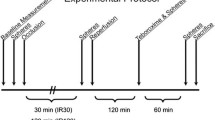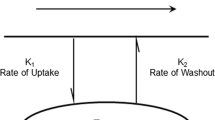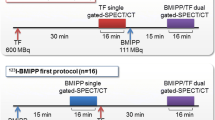Abstract
The purpose of the current study was to clarify the myocardial kinetics of technetium-99m sestamibi when the latter is administered during reperfusion. Sestamibi has in the past been given to patients following thrombolytic therapy to document reperfusion and assess salvage. However, the factors which affect sestamibi kinetics during reperfusion are not clearly defined. In this study the left circumflex coronary artery was occluded for 2 h in six dogs (group 1) and for 3 h in six dogs (group 2), followed by reperfusion. Five additional dogs were not reperfused (group 3). Sestamibi was administered during reperfusion in groups 1 and 2, and during ongoing occlusion in group 3. Regional myocardial sestamibi activity was monitored for 3 h using miniature implanted radiation detectors and gamma camera imaging. Group 1 dogs had no infarcts, group 2 had moderate infarcts (mean: 13.9%), and group 3 had large infarcts (mean: 25.2%). Three-hour fractional myocardial clearances were significantly greater for reperfused infarcted (group 2) (0.23±0.02 SEM) and for nonreperfused infarcted myocardium (group 3) (0.24±0.02) compared to control (0.10±0.01) and reperfused non-infarcted myocardium (group 1) (0.07±0.02;P<0.01). Quantitative image analysis demonstrated a significant reduction in the left circumflex/left anterior descending count ratios from initial to final scans for group 2 (0.74±0.03 to 0.65±0.03,P<0.05), and a trend towards a reduction in the count ratios from initial to final scans for group 3 (0.38±0.04 to 0.30 ±0.04;P = 0.06). Thus, probe-derived myocardial sestamibi kinetics following reperfusion do differentiate non-infarcted from infarcted myocardium. Although the detection of accelerated clearance can be demonstrated by quantitative analysis of gamma camera images in dogs, this may be technically difficult in clinical situations.
Similar content being viewed by others
References
Gibbons RJ, Perfusion imaging with99mTc-sestamibi for the assessment of myocardial area at risk and the efficacy of acute treatment in myocardial infarction.Circulation 1991; 84 Suppl 1:137–142.
Glover DK, Okada RD. Myocardial technetium 99m sestamibi kinetics after reperfusion in a canine model.Am Heart J 1993; 125:657.
Freeman I, Grunwald AM, Hoory S, Bodenheimer MM. Effect of coronary occlusion and myocardial viability on myocardial activity of technetium-99m-sestamibi.J Nucl Med 1991; 32: 292–298.
Beller GA, Glover DK, Edwards NC, Ruiz M, Simains JP, Watson DD.99mTc-sestamibi uptake and retention during myocardial ischemia and reperfusion.Circulation 1993; 87: 2033–2042.
Sinusas AJ, Trautman KA, Bergin JD, et al. Quantification of area at risk during coronary occlusion and degree of myocardial salvage after reperfusion with technetium-99m methoxyisobutyl isonitrile.Circulation 1990; 82: 1424–1437.
Beanlands RSB, Dawood F, Wen W-H, et al. Are kinetics of technetium-99m methoxyisobutyl isonitrile affected by cell metabolism and viability?Circulation 1990; 82: 1802–1814.
Reinhardt CP, Weinstein H, Wironen J, Leppo JA. The effects of triphenyl tetrazolium chloride staining on the distribution of radiolabeled pharmaceuticals.J Nucl Med 1993; 34: 46P.
Canby RC, Silber S, Pohost GM. Relations of the myocardial imaging agents99mTc-MIBI and201Tl to myocardial blood flow in a canine model of myocardial ischemic insult.Circulation 1990; 81: 289–296.
Jacobs ML, Okada RD, Daggett WM. et. al. Regional myocardial radiotracer kinetics in dogs using miniature radiation detectors.Am J Physiol 1982; 242: H849-H854.
Heymann MA, Payne BD, Hoffman JIE, Rudolph AM. Blood flow measurements with radionuclide-labeled particles.Prog Cardiovasc Dis 1977; 20: 55–79.
Glover DK, Okada RD. Myocardial kinetics of Tc-MIBI in canine myocardium after dipyridamole.Circulation 1990; 81: 628–636.
Okada RD, Glover DK, Gaffney T, Williams S. Myocardial kinetics of technetium-99m-hexakis-2-methoxy-2-methylpropyl-isonitrile.Circulation 1988; 77: 491–498.
Merhi Y, Latour J-G, Arsenault A, Rousseau G. Effect of coronary reperfusion on technetium-99m methoxyisobutylisonitrile uptake by viable and necrotic myocardium in the dog.Eur J Nucl Med 1992; 19: 503–510.
Author information
Authors and Affiliations
Rights and permissions
About this article
Cite this article
Okada, R.D., Glover, D.K., Nguyen, K.N. et al. Technetium-99m sestamibi kinetics in reperfused canine myocardium. Eur J Nucl Med 22, 600–607 (1995). https://doi.org/10.1007/BF01254560
Received:
Revised:
Issue Date:
DOI: https://doi.org/10.1007/BF01254560




